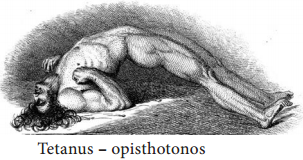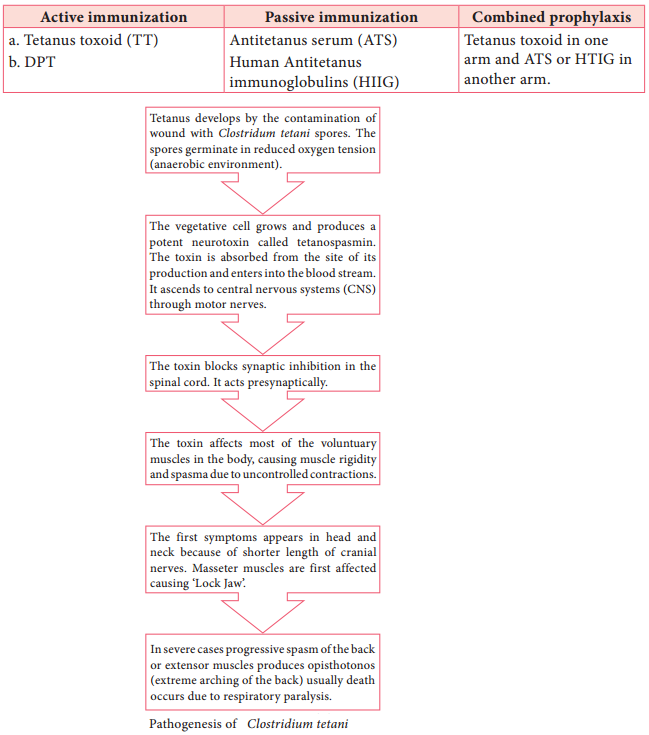Learninsta presents the core concepts of Microbiology with high-quality research papers and topical review articles.
Clostridium tetani of Medical Bacteriology
The genus Clostridium consists of anaerobic, spore forming Gram positive bacilli. The spores are wider than the bacterial bodies, giving the bacillus a swollen appearance resembling a spindle. The name Clostridium is derived from the word ‘kluster’ (a spindle).
Most species are saprophytes found in soil, water and decomposing plant and animal matter. Some of the pathogens are normal flora of intestinal tract of human and animals.
The genus Clostridium includes bacteria that causes 3 major diseases of human – Tetanus, gas gangrene and food poisoning. Clostridium pathogenicity is mainly due to production of a powerful exotoxin.
Clostridium of medical importance may be classified based on diseases they produce, which is given the Table (7.7).
Table 7.7: Clostridium sp, causing pathogenic diseases.
|
Organisms |
Diseases |
| Clostridium tetani | Tetanus |
| Clostridium perfringens | Gas gangrene |
| Clostridium botulinum | Food poisoning |
Morphology
They are Gram positive spore forming rods. The spores are spherical and terminal in position giving a drumstick appearance. They are motile and non – capsulated.
Culture Characteristics
- They are obligate anaerobes, optimum temperature is 37°C and pH is 7.4.
- It grows on ordinary media, but growth is enhanced by addition of blood and serum. Clostridia tetani grows on the following media and show the characteristic colony morphology (Table 7.8).
Table 7.8: Colony characteristics of Clostridium tetani
|
Media |
Colony Morphology |
| Blood agar | They produce α – hemolysis which subsequently develop into β – hemolysis (due to tetanolysis) it produces swarming growth. |
| Cooked meat broth (CMB) | Growth occurs as turbidity with gas formation. The meat is not digested but becomes black on prolonged incubation. |
Toxins
Clostridium tetani produces two distinct toxins namely,
- Tetanolysis (haemolysin)
- Tetanospasmin (neurotoxin)
Tetanolysis
- Heat labile and oxygen labile toxin.
- It lysis erythrocytes and also acts as neurotoxin.
Tetanospasmin
- It is heat labile and oxygen stable powerful neurotoxin.
- It is protein in nature. consisting of a large polypeptide chain (93,000 Dalton) and a smaller polypeptide chain (52,000 Dalton) joined by a disulphide bond.
- Mode of Action: Tetanospasminis a neurotoxin, which blocks the release of inhibitory neurotransmitters (glycine and gamma – amino butyric acid) across the synaptic junction.
- The toxin acts presynaptically, the abolition of spinal inhibition causes uncontrolled spread of impulses in CNS (Central Nerves System).
This results in muscle rigidity and spasms (due to the simultaneous contraction of agonists and antagonists, in the absence of reciprocal inhibition (Figure 7.11).

Pathogenesis
Clostridium tetani is the causative organism of tetanus or lock jaw disease. pathogenesis of Clostridium tetani was discussed in detail in flowchart 7.4.
Source of infection – Soil, dust, faeces.
Route of entry – Through wound
Incubation period – 6 – 12 days
Clinical Feature
It includes, pain and tingling at the site of wound, Lock jaw ortrismus (It is reduced opening of the jaws), Risus sardonicus (mouth kept slightly open), Dysphasia (impairment of the ability to speak or to understand language) and acute asphyxia.
Laboratory Diagnosis
Specimens:
Wound swab, exudates or tissue from wound.
Microscopy:
Gram staining shows Gram positive bacilli with drumstick appearance.
Culture:
The clinical specimen is inoculated on blood agar and incubated at 37°C for 24-48 hours under anaerobic conditions. The colonies are confirmed by gram staining, where it shows gram positive bacilli with drumstick appearance.
Treatment
Tetanus patients are treated in special isolated units, to protect them from noise and light which may provoke convulsions. The spasm can be controlled by diazepam (0.1 – 0.2 mg/kg) injection. Antibiotic therapy with pencilin or metroniadazole should be done for a week or more.
Prophylaxis
It is done by the following methods, which are as follows.
a. Surgical prophylaxis:
It aims at removal of foreign body, blood clots and damaged tissue in order to prevent anaerobic conditions favorable for the
germination of spores.
b. Immunoprophylaxis:
Tetanus is a preventable disease. Immune prophylaxis is of 3 types, which is given in the (Table 7.9).
Table 7.9: Immunization for tetanus.
